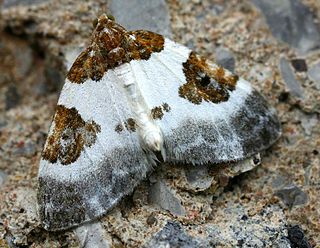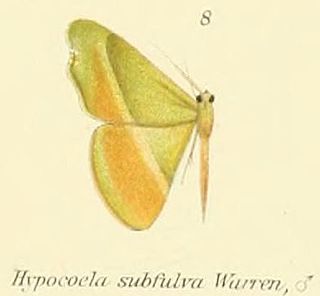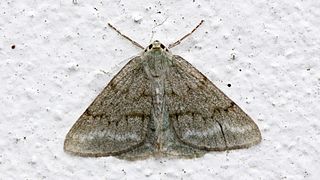
The Cidariini are the largest tribe of geometer moths in the subfamily Larentiinae. The Cidariini include many of the species known as "carpets" or, ambiguously, "carpet moths", and are among the few geometer moths that have been subject to fairly comprehensive cladistic study of their phylogeny. The tribe was described by Philogène Auguste Joseph Duponchel in 1845.

Though small in absolute diversity of genera, the Hemitheini are nonetheless the largest tribes of geometer moths in the subfamily Geometrinae. Like most Geometrinae, they are small greenish "emerald moths". The tribe was first described by Charles Théophile Bruand d'Uzelle in 1846.

Heterorachis is a genus of moths in the family Geometridae described by Warren in 1898.

Heterostegane is a genus of moths in the family Geometridae described by George Hampson in 1893.

Hypocoela is a genus of moths in the family Geometridae described by Warren in 1897.
Metallolophia is a genus of moths in the family Geometridae described by William Warren in 1895.
Omphax is a genus of moths in the family Geometridae erected by Achille Guenée in 1858.

Pingasa is a genus of moths in the family Geometridae first described by Frederic Moore in 1887.
Psilocerea is a genus of moths in the family Geometridae described by Max Saalmüller in 1880.

Somatina is a genus of moths in the family Geometridae first described by Achille Guenée in 1858.
Claude Herbulot was a French entomologist. He was born in Charleville-Mézières and died in Paris. He was a lepidopterist and specialised in moths in the family Geometridae. His collection is housed at the Zoologische Staatssammlung München.

The Pseudoterpnini are a tribe of geometer moths in the subfamily Geometrinae. The tribe was described by Warren in 1893. It was alternatively treated as subtribe Pseudoterpniti by Jeremy Daniel Holloway in 1996.
Scopula agglomerata is a moth of the family Geometridae. It was described by Claude Herbulot in 1992. It is found in Africa.
Scopula colymbas is a moth of the family Geometridae. It was described by Claude Herbulot in 1994. It is found on Socotra, an island near the Arabian Sea, which is part of Yemen.
Psilocerea psegma is a species of moth of the family Geometridae. It is found on the Comoros.
Scopula paneliusi is a moth species of the family Geometridae first described by Claude Herbulot in 1957. It is endemic to Cape Verde.
Metallolophia devecisi is a moth of the family Geometridae first described by Claude Herbulot in 1989. It is found in western Malaysia.
Pingasa griveaudi is a moth of the family Geometridae first described by Claude Herbulot in 1966. It is found on the Comoros.
Pingasa murphyi is a moth of the family Geometridae first described by Claude Herbulot in 1994. It is found in Africa.
Pingasa ultrata is a moth of the family Geometridae first described by Claude Herbulot in 1966. It is found on the Comoros in the Indian Ocean.







